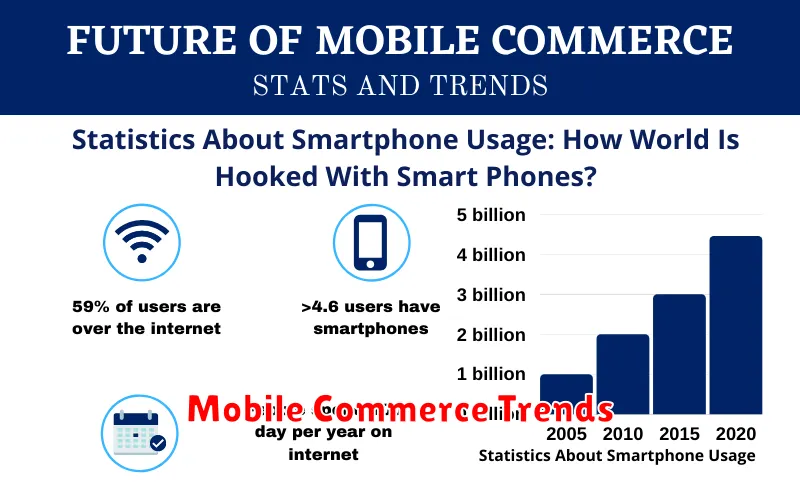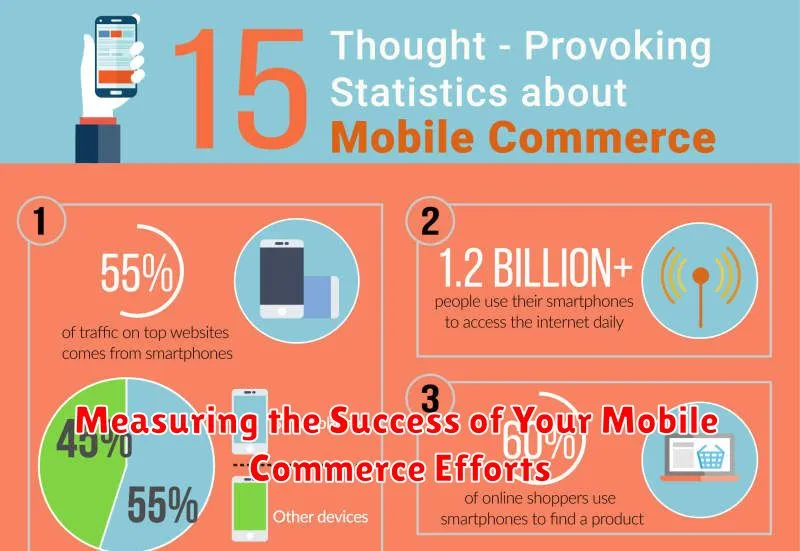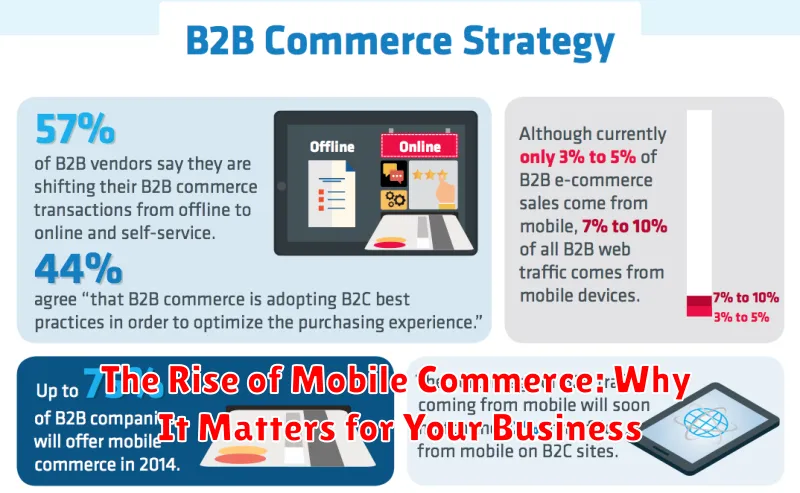Mobile commerce, or m-commerce, is rapidly transforming the e-commerce landscape. No longer a niche market, mobile shopping has become the dominant force in how consumers browse and purchase goods and services. The sheer number of smartphone users combined with increasingly sophisticated mobile apps and optimized mobile websites has created a mobile-first world. This shift toward mobile demands that businesses adapt their strategies to remain competitive and capitalize on the immense potential of this growing market. Understanding the importance of mobile commerce is no longer optional; it is essential for future success.
This article explores the key drivers behind the rise of mobile commerce and why it is crucial for businesses of all sizes to embrace this trend. We will examine the evolving consumer behavior, the impact of technological advancements, and the strategic implications for your business. By understanding the power of m-commerce, you can leverage its potential to enhance customer engagement, boost sales, and ultimately drive business growth in today’s dynamic marketplace. From optimizing your mobile presence to incorporating mobile payment solutions, adapting to the mobile-first consumer is paramount.
What is Mobile Commerce (m-commerce)?
Mobile commerce, often shortened to m-commerce, refers to the buying and selling of goods and services through wireless handheld devices such as smartphones and tablets. It encompasses a wide range of activities, including online shopping, mobile banking, and in-app purchases.
Essentially, m-commerce is e-commerce conducted on a mobile device. It leverages the increasing prevalence of mobile internet access to provide a convenient and accessible shopping experience for consumers.
Mobile commerce transactions are typically conducted over a cellular network or Wi-Fi connection, allowing users to shop from virtually anywhere at any time. This accessibility is a key differentiating factor from traditional e-commerce, which is typically accessed via desktop computers.
The Importance of Mobile Commerce
Mobile commerce has become increasingly important in today’s digital landscape. The proliferation of smartphones and widespread internet access has transformed how consumers shop and interact with businesses. This shift towards mobile has made m-commerce a critical component of any successful business strategy.
Consumers now expect a seamless shopping experience across all devices, and mobile plays a central role in this omnichannel approach. Failing to prioritize mobile can lead to missed opportunities and a decline in market share.
Mobile commerce allows businesses to reach customers anytime and anywhere. This constant accessibility expands market reach and fosters greater customer engagement. It facilitates impulse purchases and caters to the on-the-go lifestyle prevalent in modern society.
Furthermore, m-commerce provides valuable data insights into consumer behavior, allowing businesses to personalize marketing efforts and enhance customer relationships. This data-driven approach helps businesses optimize their strategies and achieve greater success in the competitive mobile market.
Benefits of Mobile Commerce for Businesses
Mobile commerce offers a multitude of advantages for businesses seeking growth and enhanced customer engagement. Increased reach is a primary benefit, as m-commerce allows businesses to connect with customers wherever they are, expanding market access beyond geographical limitations.
Improved customer experience is another key advantage. Mobile shopping offers convenience and speed, allowing customers to browse and purchase products with ease. This streamlined process fosters higher customer satisfaction and loyalty.
Personalized marketing opportunities are readily available through mobile commerce. Businesses can leverage user data to tailor offers and promotions, creating targeted campaigns that resonate with individual customer preferences. This personalization strengthens customer relationships and drives sales.
Reduced operational costs are also possible. Mobile commerce platforms often require less overhead than traditional brick-and-mortar stores, lowering expenses related to rent, utilities, and staffing.
Finally, valuable data insights are accessible through mobile commerce analytics. Businesses can track customer behavior, preferences, and purchasing patterns to better understand their target audience. This data-driven approach informs strategic decision-making and facilitates business growth.
Mobile Commerce Trends

The mobile commerce landscape is constantly evolving. Staying ahead of the curve is crucial for businesses looking to capitalize on this growing market. Several key trends are shaping the future of m-commerce.
The Rise of Social Commerce
Social media platforms are increasingly becoming transactional. Social commerce allows users to browse and purchase products directly within their favorite social media apps, streamlining the buying process and leveraging the power of influencer marketing.
Augmented Reality (AR) and Virtual Reality (VR) Experiences
AR and VR technologies are enhancing the online shopping experience by allowing customers to virtually try on clothes, visualize furniture in their homes, and interact with products in new and engaging ways.
The Growing Importance of Mobile Payments
Digital wallets and mobile payment options are becoming increasingly popular, offering seamless and secure checkout experiences. Contactless payments and in-app purchases are driving this trend.
Personalization and AI-Powered Recommendations
AI-powered personalization engines analyze user data to provide tailored product recommendations and personalized shopping experiences, increasing customer engagement and conversion rates.
How to Optimize Your Website for Mobile Commerce
Optimizing your website for mobile commerce is crucial for capturing the growing segment of mobile shoppers. A seamless and engaging mobile experience directly impacts conversion rates and customer satisfaction.
Responsive Design is paramount. Your website should adapt flawlessly to different screen sizes, ensuring consistent usability across devices. Implement a mobile-first approach, prioritizing the mobile user experience from the outset.
Site Speed is a critical factor. Mobile users expect fast loading times. Optimize images, minimize HTTP requests, and leverage browser caching to enhance performance. A slow website can lead to abandoned shopping carts and lost sales.
Streamlined Checkout is essential. Simplify the checkout process for mobile users by minimizing form fields and offering guest checkout options. Integrate mobile payment gateways like Apple Pay or Google Pay for a frictionless experience.
User-Friendly Navigation ensures easy browsing. Implement clear and concise menus, intuitive search functionality, and prominent call-to-action buttons. Guide users effortlessly through the purchase journey.
Mobile Commerce Best Practices
Optimizing your business for mobile commerce involves several key practices. Prioritize a user-friendly mobile experience. This includes a responsive design that adapts to different screen sizes and an intuitive navigation system that allows customers to easily find what they need.
Streamline the checkout process. Minimize the number of steps required to complete a purchase, and offer various payment options, including mobile wallets like Apple Pay and Google Pay. Security is paramount, so ensure your site has robust security measures in place to protect customer data.
Personalization is key. Leverage data to offer personalized product recommendations and promotions. Consider using push notifications strategically to engage customers with relevant offers and updates, but avoid being intrusive.
Finally, test and optimize continuously. Regularly analyze user behavior and make adjustments to improve the mobile experience and drive conversions.
Creating a Mobile Commerce Strategy
A successful mobile commerce strategy requires careful planning and execution. It begins with understanding your target audience and their mobile usage habits. What devices do they prefer? What are their shopping behaviors on mobile?
Define clear objectives for your mobile commerce efforts. Are you aiming to increase sales, improve brand awareness, or enhance customer loyalty? These objectives will guide your strategy development.
Choose the right platform. Will you develop a native mobile app, a mobile-optimized website, or both? Consider the resources available and the needs of your target audience. A well-designed and user-friendly mobile experience is crucial.
Integrate your mobile strategy with your overall business plan. Ensure seamless transitions between mobile and other channels, such as your website and physical stores. This omnichannel approach will create a cohesive customer experience.
Measuring the Success of Your Mobile Commerce Efforts

Tracking the right metrics is crucial to understanding the effectiveness of your mobile commerce strategy. Key Performance Indicators (KPIs) offer valuable insights into user behavior and overall performance.
Conversion Rate is a fundamental metric, showing the percentage of visitors who complete a desired action, such as making a purchase. A high conversion rate indicates a streamlined and user-friendly mobile experience.
Average Order Value (AOV) measures the average amount spent per transaction. Increasing AOV can significantly impact revenue. Strategies like offering bundled products or personalized recommendations can contribute to a higher AOV.
Cart Abandonment Rate reveals the percentage of users who add items to their cart but don’t complete the purchase. Analyzing this metric can highlight potential friction points in the checkout process. Addressing issues like complicated forms or lack of payment options can help reduce cart abandonment.
Monitoring Mobile Traffic helps you understand how users are reaching your mobile platform. Analyzing traffic sources can inform marketing strategies and optimize campaigns for better reach.
Future of Mobile Commerce
The future of mobile commerce is brimming with exciting possibilities. Augmented reality (AR) and virtual reality (VR) are poised to revolutionize how consumers interact with products, offering immersive shopping experiences. Imagine trying on clothes virtually or visualizing furniture in your home before purchasing.
Artificial intelligence (AI) will play a crucial role in personalizing the shopping journey. AI-powered chatbots can provide instant customer support, while personalized recommendations will enhance product discovery and drive sales. The increasing prevalence of voice search will further shape how consumers search and shop on their mobile devices.
Cryptocurrency and mobile wallets are likely to become more integrated, streamlining the payment process and potentially opening up new markets. The expansion of 5G technology will offer faster speeds and greater bandwidth, enabling even more seamless and interactive mobile shopping experiences. Omnichannel strategies that seamlessly blend online and offline shopping experiences will also become increasingly important.

